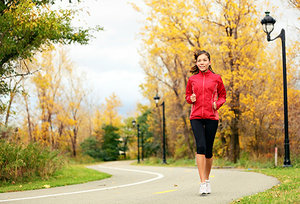| To Your Health September, 2013 (Vol. 07, Issue 09) |
By Editorial Staff
Despite unusually high temperatures in some parts of the country, October is right around the corner and the fall season is officially upon us. While the bitter chill of winter is still a few months away, fall brings shorter days, colder temperatures and rain / snow, depending on where you live; all factors that tend to keep many people indoors (and under the covers), rather than outdoors enjoying the fresh air and opportunity to exercise.
What can you do to keep fighting the fitness fight through fall and into winter, particularly if you're an outdoors enthusiast / runner who dreads the thought of becoming a gym rat for the next 4-6 months? Here are some simple strategies:
1. Weather Watch: Staying on schedule is an important component of any successful exercise program, and as we all know, Mother Nature just doesn't care. The solution to this dilemma is to check the weather often, particularly at the start of each week, so you can plan your outdoor exercise sessions accordingly. Whether that means you bunch your workouts / runs at the beginning of the week, before that big storm sweeps in, or just prepare to fight through it with the proper clothing (see below), keeping an eye on the weather forecast online or via an app[1] is the first step in ensuring you stay on course.
2. Bundling Basics: Any runner will tell you that less is more when it comes to what you wear, but that advice changes a bit when you're faced with a driving rainstorm or 35-degree temperatures. Whether you're going for a quick jog, a long run, or participating in an outdoor boot camp, make sure you can handle the conditions. That means choosing clothing that will keep you dry if necessary, but is also breathable so you don't overheat; and dressing in layers[2] you can progressively remove (for example, a light sweatshirt you can take off and tie around your waist) as the exercise intensity / duration builds.
 3. Shoe Sensibility: The right pair of shoes can make all the difference when it comes to your workout, and this is particularly true when faced with less-than-ideal outdoor conditions. Shoes that are overly worn in the top or sole / tread area are apt to take on water and/or cause a nasty slip during even a light rain or icy morning. And shoes that don't account for your specific foot characteristics and gait tendencies – for example, if you have wide feet, tend to roll your feet[3] excessively inward (or not enough) when you run / walk (overpronation / underpronation), etc. – can cause pain that will sideline you for days, weeks or even longer. What's more, it's important to pick the shoe that best suits not only the type of exercise (e.g., running vs. jumping vs. playing a sport), but also individual preference (e.g., stability vs. motion control vs. shock absorption / cushioning).
3. Shoe Sensibility: The right pair of shoes can make all the difference when it comes to your workout, and this is particularly true when faced with less-than-ideal outdoor conditions. Shoes that are overly worn in the top or sole / tread area are apt to take on water and/or cause a nasty slip during even a light rain or icy morning. And shoes that don't account for your specific foot characteristics and gait tendencies – for example, if you have wide feet, tend to roll your feet[3] excessively inward (or not enough) when you run / walk (overpronation / underpronation), etc. – can cause pain that will sideline you for days, weeks or even longer. What's more, it's important to pick the shoe that best suits not only the type of exercise (e.g., running vs. jumping vs. playing a sport), but also individual preference (e.g., stability vs. motion control vs. shock absorption / cushioning).
Lifelong fitness isn't just a tag line; it's a way of life. Make sure you keep pushing toward your goals – and then making new ones – this fall and winter by adopting these and other strategies that get you outdoors, on the go and taking your fitness to the next level, regardless of the weather. Talk to your doctor for more great ways to exercise safely and consistently through 2013 and into 2014.

No comments :
Post a Comment